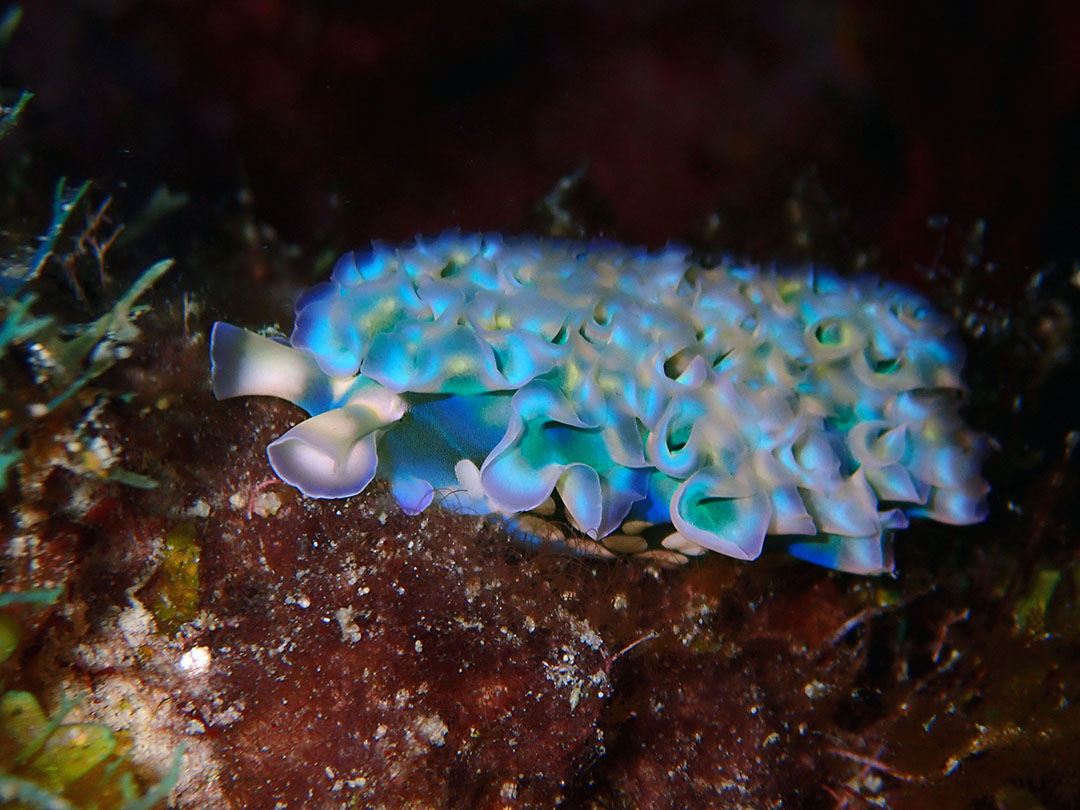Synonyms: Tridachia crispata
Description: A large species, reaching almost 15 cm. Highly variable in pattern and color, ranging from light green to deep blue. Parapodia highly ruffled. Rhinophores scrolled. Common on and around coral reefs.
Distribution: Widespread in the Tropical Western Atlantic and Caribbean (Marcus, 1980; Pierce et al., 2006).
Food Plants: Halimeda, Penicillus, Bryopsis
Development: Lecithotrophic. Eggs hatch in about three weeks, depending on temperature. Veligers settle within a few days, and commence feeding on Bryopsis plumosa.
Scientific Literature:
Vital XG, Rey F, Cartaxana P, Cruz S, Domingues MR, Calado R, Simões N. (2021) Pigment and Fatty Acid Heterogeneity in the Sea Slug Elysia crispata Is Not Shaped by Habitat Depth. Animals 11:3157. [NH] [Cr]
Middlebrooks ML, Curtis NE, Pierce SK. (2019) Algal Sources of Sequestered Chloroplasts in the Sacoglossan Sea Slug Elysia crispata Vary by Location and Ecotype. Biol Bull. 236: 88-96. [F] [K] [Cr]
Dionísio G, Faleiro F, Bispo R, Lopes AR, Cruz S, Paula JR, Repolho T, Calado R, Rosa R. (2018) Distinct Bleaching Resilience of Photosynthetic Plastid-Bearing Mollusks Under Thermal Stress and High CO(2) Conditions. Front Physiol. 9:1675. [K] [NH] [Cr]
de Sisto, M., Crescini, R., Villalba, W., Rios, B., Gomez, V., Mata, Y. (2016) Sacoglossans Opisthobranchia: Sacoglossa) from Nueva Esparta state and Los Frailes, Venezuela. Revista Mexicana De Biodiversidad 87: 42-48 [Ca] [Cr] [Pa] [Se] [Su]
Sanvicente-Añorve, L., Solís-Weiss, V., Ortigosa, J., Hermoso-Salazar, M., Lemus-Santana, E. (2012) Opisthobranch fauna from the national park arrecife alacranes,southern Gulf of Mexico. Cahiers de Biologie Marine, 53 (4), pp. 447-460. PDF [NH] [Cr] [Pa] [Su] [Tu]
Krug, P.J. (2009) Not My “Type”: Larval dispersal dimorphisms and bet-hedging in opisthobranch life histories. Biological Bulletin, 216 (3), pp. 355-372. PDF [NH] [Co] [Cr] [Pp] [Pr] [Su] [Tu] [Zu]
Pierce, S.K., Curtis, N.E., Massey, S.E., Bass, A.L., Karl, S.A., Finney, C.M. (2006) A morphological and molecular comparison between Elysia crispata and a new species of kleptoplastic sacoglossan sea slug (Gastropoda: Opisthobranchia) from the Florida Keys, USA. Molluscan Research, 26 (1), pp. 23-38. Abstract [F] [K] [NH] [Cr] [Cl]
Jeffery, D.W., Perkins, M.V., White, J.M. (2005) Synthesis of an analogue of the marine polypropionate tridachiahydropyrone. Organic Letters, 7 (3), pp. 407-409. PDF [NP] [Cr]
Williams, S.I., Walker D.I. (1999) Mesoherbivore-macroalgal interactions: feeding ecology of sacoglossan sea slugs (Mollusca, Opisthobranchia) and their effects on food algae. Oceanogr Mar Biol Annu Rev 37: 87-128 [At] [Au] [Ca] [Cr] [Di] [Ev] [Ex] [Fi] [Fu] [He] [Ma] [Or] [Pa] [Pu] [Se] [Su] [Ti] [Tu] [Vi] Excellent review of food sources
Gavagnin, M., Mollo, E., Castelluccio, F., Montanaro, Elysia RissoD., Ortea, J., Cimino, G. (1997) A novel dietary sesquiterpene from the marine sacoglossan Tridachia crispata. Natural Product Letters, 10 (2), pp. 151-156. Abstract [NP] [Cr]
Gavagnin, M., Mollo, E., Cimino, G., Ortea, J. (1996) A new ?-dihydropyrone-propionate from the Caribbean sacoglossan Tridachia crispata. Tetrahedron Letters, 37 (24), pp. 4259-4262. Abstract [NP] [Cr]
Thompson, T.E., Jarman, G.M. (1989) Nutrition of Tridachia crispata (Mörch) (sacoglossa). Journal of Molluscan Studies, 55 (2), pp. 239-244. Abstract [F] [NH] [Cr]
Ksebati, M.B., Schmitz, F.J. (1985) Tridachiapyrones: Propionate-derived metabolites from the sacoglossan mollusc Tridachia crispata. Journal of Organic Chemistry, 50 (26), pp. 5637-5642. Abstract [NP] [Cr]
Jensen, K., Clark, K.B. (1983) Annotated checklist of Florida Ascoglossan Opisthobranchia. Nautilus, 97 pp. 1-12 PDF [NH] [Cr]
Ireland, C., and Faulkner, D.J. (1981) The metabolites of the marine mollusk Tridachiella diomedea and Tridachia crispata. Tetrahedron 37 (suppl 1): 233-240 [Cr] [Di]
Marcus, E. (1980) Review of Western Atlantic Elysiidae (Opisthobranchia Ascoglossa) with a Description of a New Elysia Species. Bulletin of Marine Science 30 (1) pp. 54-79.
Ireland, C., Faulkner, D.J., Finer, J.S., Clardy, J. (1979) Crispatone, a metabolite of the opisthobranch mollusc Tridachia crispata [1]. Journal of the American Chemical Society, 101 (5), pp. 1275-1276. Scanned version [NP] [Cr]
Trench, R.K., Boyle, J.E., Smith, D.C. (1974) The association between chloroplast of Codium fragile and the mollusc Elysia viridis. III. Movement of photosynthetically fixed 14C in tissues of intact living E. viridis and in Tridachia crispata. Proceedings of the Royal Society of London – Biological Sciences, 185 (1081), pp. 453-464. JStor PDF [K] [Cr] [Vi]
Trench, RK, ME Trench, L Muscatine (1972) Symbiotic chloroplasts; their photosynthetic products and contribution to mucus synthesis in two marine slugs The Biological Bulletin, 142 no. 2 335-349 [K] [Cr] [Di]
Taylor, D.L. (1971) Photosynthesis of symbiotic chloroplasts in Tridachia crispata (Bërgh). Comparative Biochemistry and Physiology — Part A: Physiology, 38 (1), pp. 233-236. PDF [K] [Cr]
Trench, R.K., Smith, D.C. (1970) Synthesis of pigments in symbiotic chloroplasts. Nature 227: 196 [Cr]
Trench,RK, RW Greene, BG Bystrom (1969) Chloroplasts as functional organelles in animal tissues J. Cell Biol. 42: 404-417 [F] [K] [Cr] [Di]
Trench, R.K. (1969) Chloroplasts as functional endosymbionts in the mollusc Tridachia crispata (Bërgh), (Opisthobranchia, Sacoglossa). Nature, 222 (5198), pp. 1071-1072. PDF [K] [Cr] [Paper chromatography of pigments]
Morch, O.A.L (1863) Contributions a la faune malacologique des Antilles danoises. Journal de Conchyliologie 11 pp. 21-43 [NH] [Cr]

Recent Comments